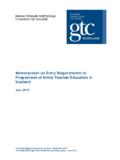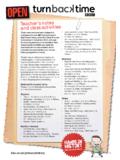Transcription of Humes, Walter (2013) Curriculum for Excellence and ...
1 82 Curriculum FOR Excellence AND interdisciplinary learning Walter Humes University of Stirling ABSTRACT This paper examines the recommendations contained in Curriculum for Excellence (CfE) aimed at encouraging the integration of knowledge, skills and understanding across different areas of the Curriculum . It first outlines what is said in the official CfE documentation and supporting materials produced by Education Scotland, noting the absence of references to earlier work on Curriculum integration and interdisciplinarity. The sections that follow focus on four issues that are critical for the coherence and success of attempts to promote interdisciplinary work: the way in which interdisciplinarity is conceptualised; ensuring that cross-curricular connections are convincing and intellectually challenging; devising pedagogic strategies that are effective; and addressing operational obstacles to interdisciplinary work.
2 The paper ends by posing a series of questions that need to be considered if the aims of interdisciplinary learning are to be achieved. It is suggested that, at present, these aims are well-intentioned but rather ill-defined. INTRODUCTION In July 2012 the Young Academy of Scotland (YAS) Curriculum for Excellence Working Group organised a workshop to explore aspects of interdisciplinary learning . YAS was established in 2011 by the Royal Society of Edinburgh (RSE). The rationale for this development is explained on the RSE website: The Young Academy brings together some of the most able and innovative young academics, entrepreneurs, artists and professionals in Scotland, with the aim of harnessing their creativity to develop a coherent and influential voice on behalf of the most talented people of their generation. The Academy members will be encouraged to work across disciplines to consider many of the most challenging issues facing society either domestically or globally, in fields as diverse as climate change, the economy, ethics or the arts.
3 ( ) The emphasis on working across disciplines helps to explain YAS s interest in the interdisciplinary aspects of Curriculum for Excellence (CfE). Presentations at the July 2012 workshop included a report from a voluntary organisation which had developed interdisciplinary materials for schools, input from academics who had written about CfE, examples of projects in primary and secondary schools, and reflections from a retired headteacher and a former senior member of the inspectorate on both the potential of interdisciplinary work and the barriers to its effective implementation. This paper is based on the input to the event by the present writer, expanded and revised in the light of the other contributions and the wider discussion which took place. It represents only the views of the author and should not be regarded as a statement of YAS s thinking on the subject.
4 The first part of the paper gives an overview of what CfE documents say about interdisciplinary learning and subsequent exemplars available on the Education Scotland website. It draws attention to some earlier attempts to promote interdisciplinary learning as well as to critiques of the thinking underlying these approaches. In subsequent sections four perspectives on interdisciplinary learning are explored: conceptual, curricular, pedagogic and operational. The paper ends by posing a number of questions that require further elucidation if the CfE recommendations on interdisciplinary learning are to be embedded successfully in classroom practice. Humes, Walter (2013) Curriculum for Excellence and interdisciplinary learning , Scottish Educational Review 45 (1), 82-93 83 WHAT DOES CfE HAVE TO SAY ABOUT interdisciplinary learning ? The first CfE document appeared in 2004 setting out the broad principles of the proposed reform programme (Scottish Executive, 2004).
5 These included the now familiar four capacities of successful learners, confident individuals, effective contributors and responsible citizens. The document also stated that There should be clear links between the different aspects of young people s learning , including opportunities for extended activities which draw different strands of learning together . This brief statement was fleshed out in Building the Curriculum 3 (Scottish Government, 2008): The Curriculum should include space for learning beyond subject boundaries, so that children and young people can make connexions between different areas of learning . interdisciplinary studies, based upon groupings of experiences and outcomes from within and across Curriculum areas, can provide relevant, challenging and enjoyable learning experiences and stimulating contexts to meet the varied needs of children and young people.
6 (Scottish Government, 2008: 21) Note that reference is made to different curricular areas or subjects . The overarching structure of CfE is described in terms of eight curricular areas - expressive arts, health and wellbeing, languages, mathematics, religious and moral education, sciences, social studies and technologies. So what was being proposed was certainly not an abandonment of traditional subjects. Indeed in Building the Curriculum 3, immediately before the section on interdisciplinary learning , it is stated explicitly: Subjects are an essential feature of the Curriculum , particularly in secondary school. They provide an important and familiar structure for knowledge, offering a context for specialists to inspire, stretch and motivate. Throughout a young person s learning there will be increasing specialisation and greater depth, which will lead to subjects increasingly being the principal means of structuring learning and delivering outcomes.
7 (ibid: 20) These statements help to explain some of the arguments and counter-arguments that have arisen between advocates and critics of interdisciplinary learning (IDL). The wider academic literature reflecting different perspectives will be discussed in the next section: for the moment a broad characterisation of the Scottish debate will suffice. Those who favour a more radical approach to curricular reform than that offered by CfE say that there has been a loss of nerve, that if you want real flexibility you have to challenge the subject-based Curriculum much more fundamentally. They sometimes further argue that it is the subject fiefdoms of the secondary school that have prevented Scottish education from embracing change. It is claimed that these serve the interests of conservative teachers rather than the interests of learners and the needs of employers who are seeking different kinds of skills from those associated with academic learning .
8 On the other hand there are those who say that it would be a mistake to abandon ways of structuring knowledge that have served education well in favour of something that is often vague and poorly understood. Traditional subjects have clearly defined bodies of knowledge with well-established methods of investigation and standards for determining the validity of new knowledge. Some critics, who are not totally hostile to interdisciplinary learning , argue that you need to have a good grasp of the disciplines before you can engage in worthwhile inter-disciplinary thinking. On the Education Scotland website there are many references, both general and specific, to interdisciplinary learning ( ). It would be cumbersome to give detailed references to every point that is mentioned in what follows, but where a document is deemed particularly important the exact source will be provided. IDL is said to encourage an inquisitive attitude and strengthen motivation as well as helping to develop confidence in facing challenges, both intellectual and practical.
9 Moreover, learning 84 of this kind is connected and directly related to real-life experiences . Other claims include exploration of in-depth topics, issues and problems , the promotion of critical thinking and the development of skills for learning , life and work . Examples of IDL work undertaken by both primary and secondary schools are given, in some cases supported by videos and other materials. The range of work is extensive. Some might be regarded as cross-disciplinary rather than interdisciplinary , in the sense that the emphasis remains on separate subjects ( maths and physics, or English and history) though there is a desire to make connections between them. Others look at social topics which require input from a variety of sources: sustainable housing; emergency services; traveller children; electric transport; financial literacy; the legacy of major events (such as the Olympics and Commonwealth Games).
10 There are also projects on Scotland (linked to global citizenship), China, the United Nations and the culture and language of linked schools in other countries. Reports of some of these projects include not only accounts of Curriculum content and teaching methodology but also planning and operational issues, assessment and evaluation. It is evident that a great deal of thoughtful work has been undertaken in primary and secondary schools across Scotland, though the response from primary schools seems to have been stronger. As part of the development strategy of Curriculum for Excellence , a number of Excellence Groups were established in 2010. One of these looked at Higher Order Skills with a remit to consider deep learning and advanced thinking skills across all areas of learning (Scottish Government, 2011: 5). Among the ambitious cognitive skills which the group recommends is interdisciplinary and multi-context learning (ibid: 4).





